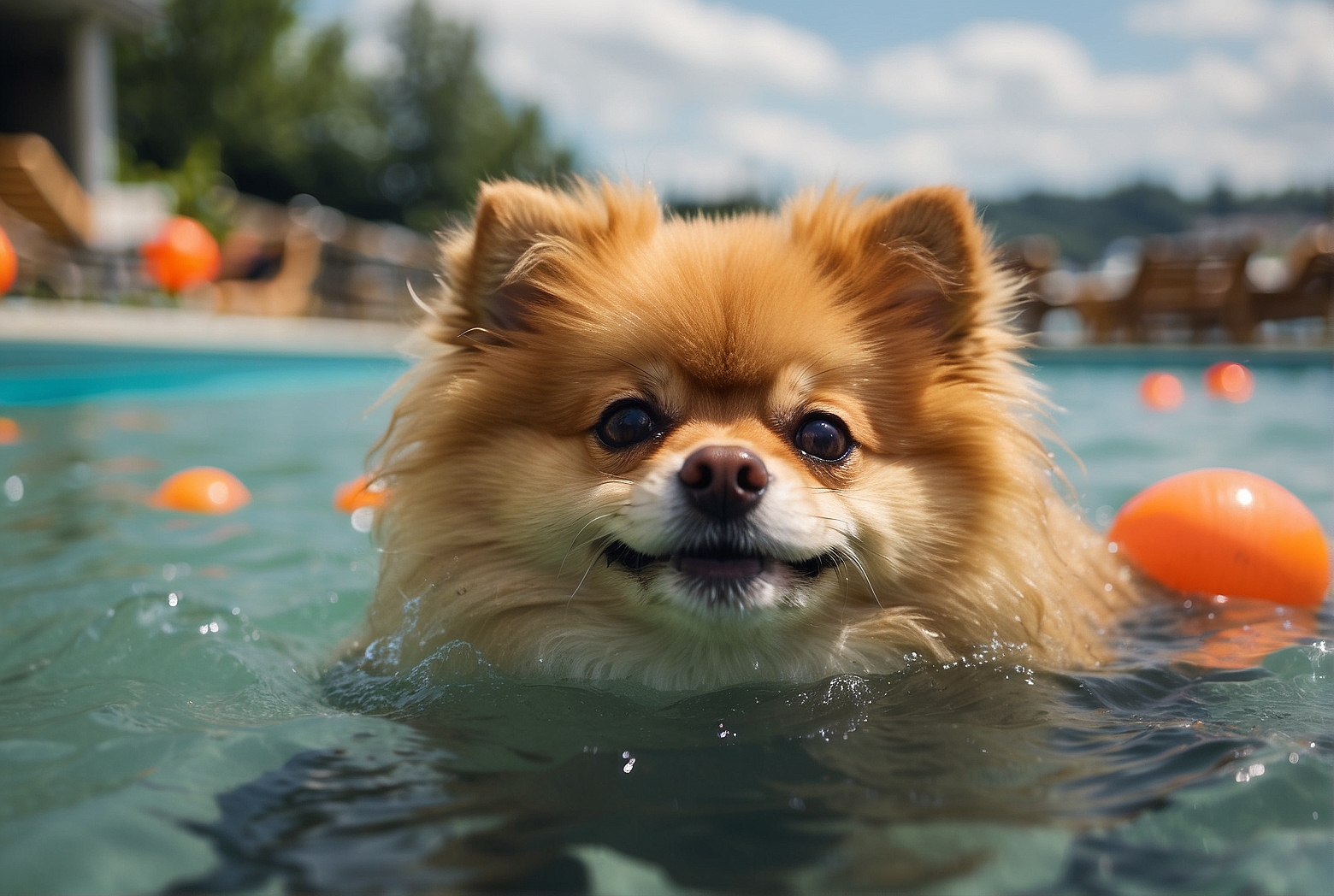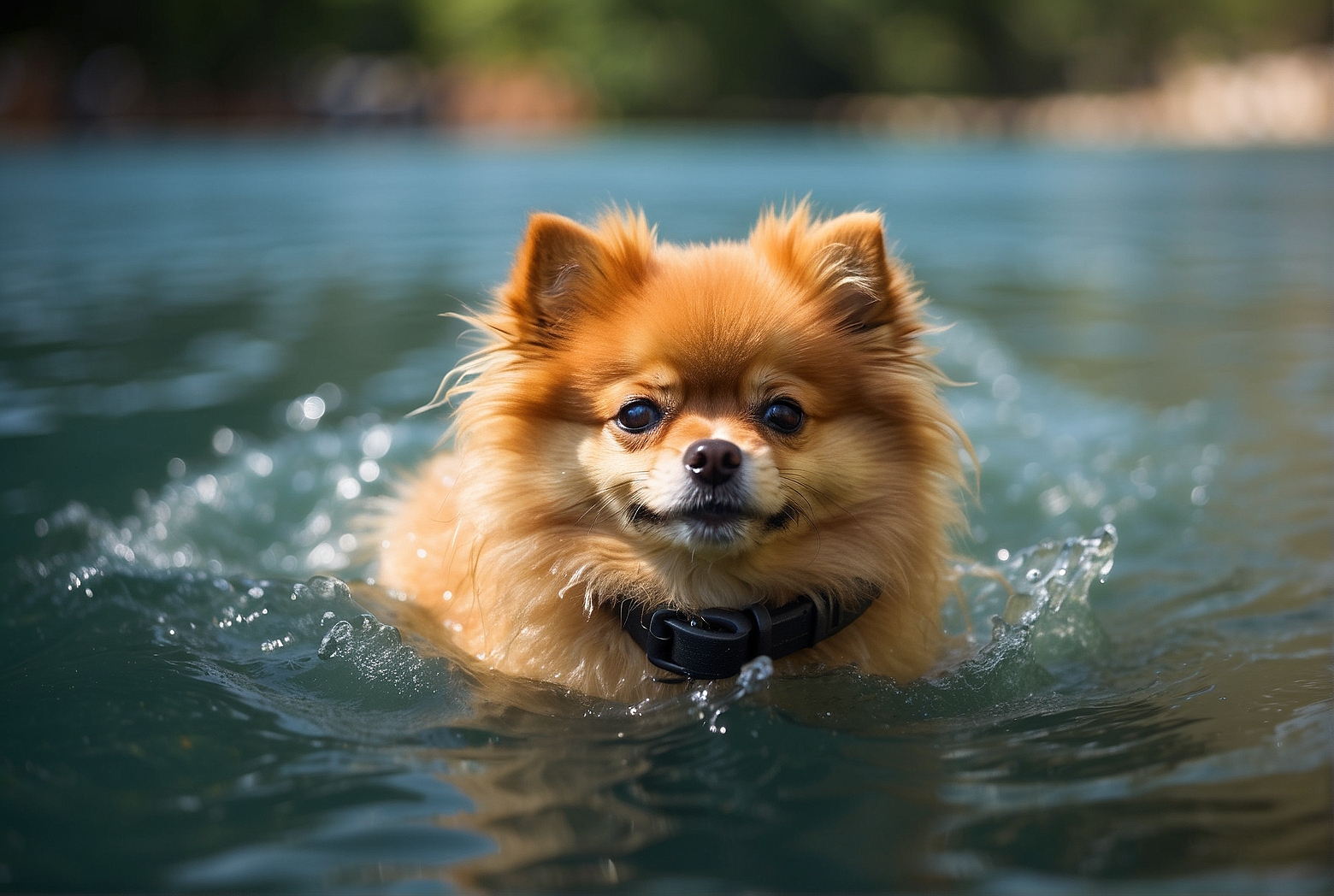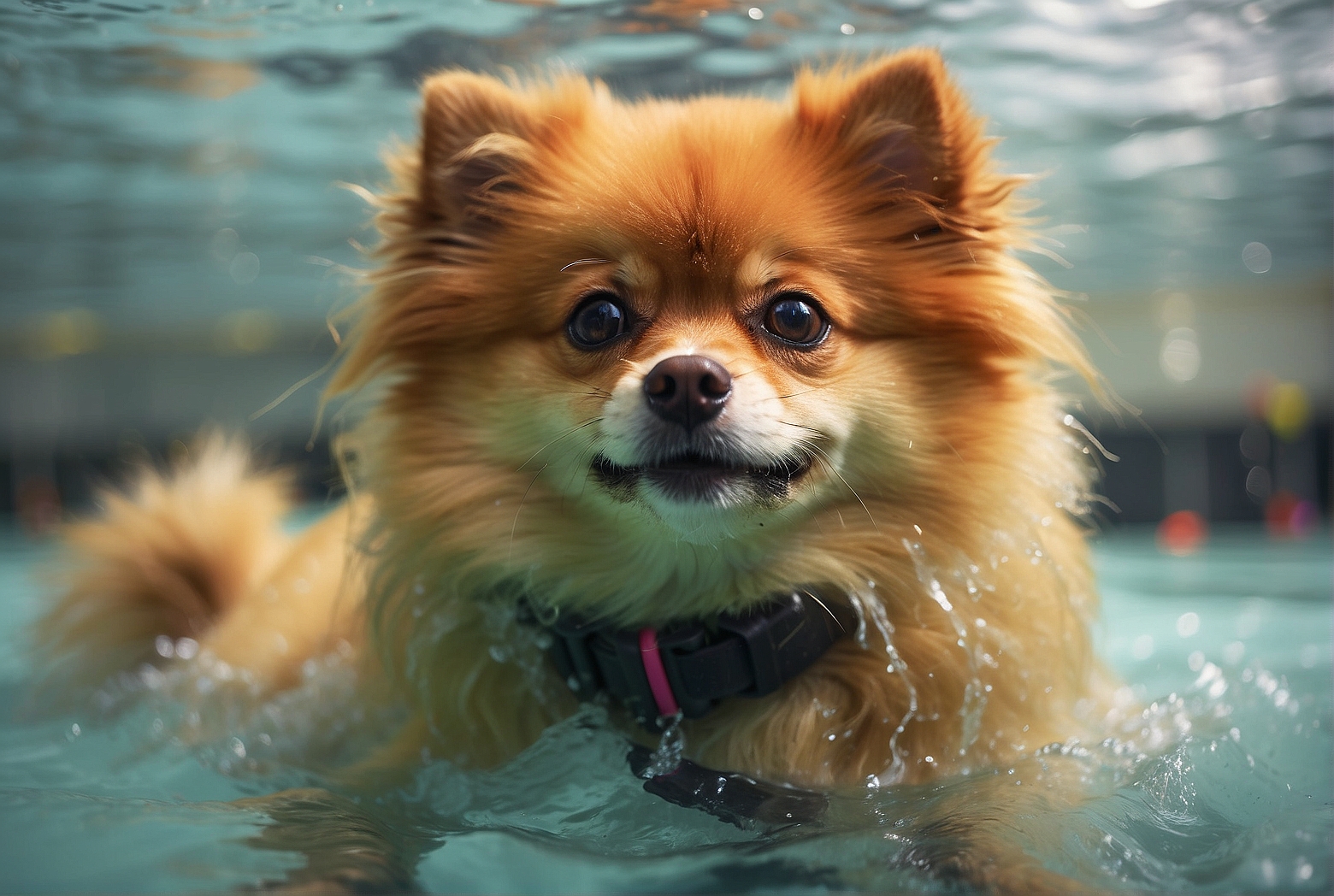Pomeranians, often recognized for their fluffy coats and small size, are charming companions that bring joy to many households. However, when it comes to swimming, there seems to be a divide among these adorable little dogs. While some Pomeranian owners would swear their furry friends are avid swimmers, others claim that their Pomeranians are less inclined to dive into the water. So, the question arises: do Pomeranians truly enjoy swimming? In this article, we will explore this intriguing topic and shed light on the water-related tendencies of these lovable canines.
Pomeranians and Their Water Resistance
Pomeranians, despite their small size and fluffy appearance, actually have a surprising connection to water. Their water resistance can be traced back to their ancestry and natural instincts. While not all Pomeranians may enjoy swimming, many have the potential to become confident and skilled swimmers with the right training and introduction to water. Understanding their instincts and providing early exposure to water is key in helping Pomeranians adapt and enjoy aquatic activities.
The Pomeranian’s Ancestry and Connection to Water
Believe it or not, Pomeranians have a fascinating ancestry that includes Nordic breeds such as the Arctic Spitz. These dogs were bred to withstand the extreme weather conditions of the Arctic region, which required them to be comfortable both on land and in the water. This genetic background may explain why some Pomeranians possess a natural affinity for water and exhibit water-resistant features in their coat.
Understanding Pomeranians’ Natural Instincts
Pomeranians have inherited certain instincts from their ancestors that contribute to their potential enjoyment of swimming. Their thick double coat, composed of a harsh outer layer and a soft undercoat, acts as insulation, keeping them warm even when exposed to water. Additionally, Pomeranians have webbed feet, which aids in propulsion and maneuverability in the water. These physical adaptations suggest that, given the right circumstances, Pomeranians may have a natural inclination to embrace aquatic activities.
The Importance of Early Introduction to Water
It is crucial to introduce Pomeranians to water at an early age to help them build confidence and familiarity. Early exposure can be as simple as allowing them to wade in shallow water or playing with water toys in a controlled setting. By gradually introducing them to different water environments, such as pools, lakes, or even bathtubs, you can help them become comfortable and at ease around water. Patience and positive reinforcement are key during this process, as it allows them to associate water with pleasant experiences.
Pomeranians and Hydrotherapy
Hydrotherapy, a form of physical therapy in water, can be highly beneficial for Pomeranians. This low-impact exercise can help improve muscle strength, joint mobility, and overall fitness. Hydrotherapy is particularly useful for Pomeranians with musculoskeletal conditions or recovering from surgery as it provides a supportive and buoyant environment. It is recommended to consult with a professional hydrotherapist who can tailor the sessions to meet your Pomeranian’s specific needs and ensure their safety throughout the process.

Factors Affecting Pomeranians’ Enjoyment of Swimming
While some Pomeranians may take to swimming naturally, others may require more encouragement and support. Various factors can influence their enjoyment of swimming, including their individual temperament, previous experiences with water, and their overall health and fitness. It’s important to remember that not all Pomeranians are natural swimmers, and forcing them into water against their will can lead to fear and anxiety. Each Pomeranian is unique, and it’s crucial to respect their preferences and comfort levels when it comes to water activities.
Pomeranian Water Adaptation Training
To help Pomeranians adapt to swimming, water adaptation training can gradually acclimate them to different water environments. Start by introducing them to shallow water, such as a baby pool or a gentle, shallow shoreline. Allow them to explore at their own pace and provide positive reinforcement for any signs of comfort or curiosity. Over time, gradually increase the depth of water and engage in gentle water activities, such as retrieving toys or encouraging them to paddle with their front paws. Remember to always maintain a supportive and positive atmosphere to build their confidence and trust.
Swim Basics for Pomeranians
When your Pomeranian begins to swim, it’s important to ensure their safety and well-being. Start with short swimming sessions to prevent overexertion, as Pomeranians may tire quickly due to their small size. Use a well-fitting canine life jacket to provide additional buoyancy and support, especially for inexperienced swimmers. While Pomeranians have some natural ability to swim, it’s essential to supervise them closely and gradually increase the duration and intensity of their swimming sessions as they build their stamina.
Water Safety Measures for Pomeranians
When allowing your Pomeranian to swim, it’s crucial to prioritize their safety. Choose swimming locations that are safe and free from potential hazards such as strong currents, deep waters, or sharp objects. Always be aware of your surroundings to avoid any potential dangers that could endanger your furry friend. It’s recommended to invest in a sturdy fence or barrier to prevent unsupervised access to bodies of water, such as backyard pools or ponds. By implementing these safety measures, you can enjoy swimming activities with your Pomeranian while minimizing the risk of accidents.
Building Confidence in the Water
Building confidence is a gradual process when it comes to water activities. Be patient and understanding with your Pomeranian, especially if they show signs of fear or hesitation. Encourage them with positive reinforcement and rewards for every small step they take towards overcoming their fears. Avoid rushing the process and provide plenty of praise and treats when they exhibit bravery or make progress in the water. With time and consistent support, your Pomeranian can develop into a confident and content swimmer, allowing them to enjoy the water to the fullest.
Using Life Jackets for Pomeranians
Life jackets can be a fantastic tool for ensuring the safety and comfort of your Pomeranian during swimming sessions. Especially for Pomeranians who may be less proficient swimmers or those who are new to swimming, a well-fitting life jacket can provide peace of mind. These jackets are designed to keep your Pomeranian buoyant and afloat, giving them additional support as they navigate through the water. Always choose a life jacket that fits properly and has a secure fastening mechanism to prevent any discomfort or potential accidents.

Supervision and Swimming with Pomeranians
Regardless of your Pomeranian’s swimming abilities, it is imperative to provide constant supervision whenever they are near or in water. Even skilled swimmers can encounter unforeseen circumstances or become fatigued. Always keep a watchful eye on your Pomeranian, remaining vigilant for any signs of distress, exhaustion, or potential danger. Remember, your presence and attention can make a significant difference in their safety and overall enjoyment of swimming activities.
Physical Benefits of Swimming for Pomeranians
Swimming offers numerous physical benefits for Pomeranians. This low-impact exercise provides an excellent cardiovascular workout, improving their overall stamina, strength, and endurance. The buoyancy of water reduces stress on joints, which can be particularly beneficial for Pomeranians with arthritis or other joint issues. Swimming also helps to build and tone muscles, promoting a healthy physique. Regular swimming sessions can contribute to weight management, reduce the risk of obesity, and support a healthy cardiovascular system.
Mental Stimulation through Swimming
Swimming is not just a physical activity; it also offers mental stimulation for Pomeranians. The novelty of being in water engages their senses and challenges their cognitive abilities. Swimming encourages problem-solving skills, coordination, and spatial awareness as they navigate through the water. The mental stimulation provided by swimming can be particularly helpful for Pomeranians with high energy levels or those who require mental enrichment to prevent boredom and destructive behaviors.
Potential Health Risks of Swimming for Pomeranians
While swimming can offer numerous benefits for Pomeranians, it’s essential to be aware of potential health risks. Chlorine, commonly used in pools, can cause skin irritation and allergic reactions in some Pomeranians. Additionally, bacteria present in natural bodies of water can lead to gastrointestinal issues or even skin infections. It’s important to rinse your Pomeranian thoroughly with fresh water after swimming to remove any residual chemicals or harmful bacteria. Regular veterinary check-ups and preventive measures, such as vaccinations and parasite control, can minimize the potential health risks associated with swimming.
Common Swimming-Related Issues in Pomeranians
Pomeranians may encounter specific swimming-related issues that require attention and care. These include ear infections, which can occur when water enters the ear canal during swimming. It’s crucial to dry your Pomeranian’s ears thoroughly after swimming and monitor for any signs of discomfort or infection. Another common issue is dry skin and coat damage due to prolonged exposure to water and harsh chemicals. Regular grooming, moisturization, and using dog-specific shampoo and conditioner can help maintain a healthy coat and skin condition.
Preventing Water-Related Accidents
Preventing water-related accidents should be the utmost priority when swimming with your Pomeranian. Always be cautious around open bodies of water and avoid unsupervised access to pools or other aquatic environments. Equip your backyard pool with a secure fence or cover to prevent accidental falls or unauthorized entry. In addition, it’s vital to teach your Pomeranian basic swimming skills, such as locating the pool steps or exit points, to ensure they can safely navigate themselves out of the water if needed.
Alternative Water Activities for Pomeranians
Swimming is not the only water activity suitable for Pomeranians. If your Pomeranian doesn’t enjoy swimming or if swimming is not feasible, there are alternative water activities to explore. Water treadmill exercises or hydrotherapy sessions can provide similar benefits to swimming in a controlled and supervised environment. Additionally, interactive water toys and games, such as sprinklers or filled kiddie pools, can offer fun and refreshing ways for your Pomeranian to cool down during hot weather.
Gradual Water Introduction
When introducing your Pomeranian to water, it’s important to proceed gradually. Start with small steps, such as allowing them to explore water with their paws or attempting shallow wading. Observe their reaction and provide positive reinforcement for any signs of comfort or curiosity. Avoid rushing the process and allow your Pomeranian to set their own pace. By respecting their boundaries and gradually increasing their exposure to water, you can help them build confidence and create a positive association with aquatic activities.
Positive Reinforcement and Rewards
Positive reinforcement is a highly effective method to encourage your Pomeranian’s enthusiasm for swimming. Praise and reward them with treats, verbal affirmations, and gentle petting whenever they display confidence or make progress in the water. Positive reinforcement creates a bond of trust and provides motivation for your Pomeranian to continue exploring and enjoying swimming activities. Remember, patience and consistency are key when using positive reinforcement, ensuring your furry friend understands that swimming is a rewarding and enjoyable experience.
Choosing Suitable Swimming Locations
Not all swimming locations are equally suitable for Pomeranians. When selecting a swimming spot, consider the depth of the water, the presence of any currents or waves, and the overall safety of the environment. Opt for calm and shallow waters, such as designated dog-friendly beaches or shallow pools specifically designed for dogs. These locations provide a controlled environment with minimal risks, allowing your Pomeranian to swim and have fun in a safe and secure setting.
Monitoring Pomeranians’ Stamina
Pomeranians may possess a limited stamina when it comes to swimming due to their small size and relatively high energy expenditure. It’s crucial to monitor their stamina during swimming sessions and avoid overexertion. Start with shorter swimming periods and gradually increase the duration as your Pomeranian builds their strength and endurance. Pay close attention to any signs of fatigue, such as excessive panting or reluctance to continue swimming, and provide them with sufficient rest and water breaks to prevent exhaustion.
Avoiding Overexertion in the Water
While it’s important to encourage your Pomeranian’s physical activity in water, overexertion can pose risks to their health and well-being. Pomeranians may have a strong drive to please and may push themselves beyond their physical limitations to keep up with their owners. Make sure to provide regular breaks, especially during intense swimming sessions, to allow your Pomeranian to rest and recuperate. Monitor their breathing and energy levels closely and adjust the intensity of exercises accordingly.
Protecting Pomeranians’ Ears from Water
Pomeranians are prone to ear infections due to their floppy ears and water entering the ear canal during swimming. To protect their ears, gently insert cotton balls or earplugs designed for dogs into their ear canals before swimming. This serves as a barrier that prevents water from entering the ears. After swimming, remember to remove the cotton balls or earplugs and thoroughly dry their ears with a clean towel to reduce the risk of moisture-related ear infections.
Pomeranian Physical Limitations in Water
Despite their potential for water enjoyment, Pomeranians have certain physical limitations that should be taken into consideration. Their small size, short legs, and relative lack of endurance limit their ability to swim for long periods or cover significant distances. It’s crucial to be mindful of their limitations and adjust swimming activities to suit their needs. Avoid placing excessive demands on your Pomeranian and ensure they have ample opportunities for rest and recovery when engaging in water-related activities.
Potential Allergic Reactions to Chlorine
Chlorine is commonly used in pools to maintain water cleanliness but can cause skin irritation and allergic reactions in some Pomeranians. If your Pomeranian shows signs of discomfort or reddening of the skin after swimming in a chlorinated pool, it’s recommended to rinse them thoroughly with fresh water to remove any residual chemicals. Additionally, consult with your veterinarian to determine if your Pomeranian is prone to chlorine allergies and explore alternative swimming options, such as natural bodies of water or specially treated pools that use alternative disinfection methods.
Water Temperature for Pomeranian Swimming
Pomeranians are sensitive to temperature extremes, including cold water. It’s important to consider the water temperature when swimming with your Pomeranian. Cold water can quickly chill their small bodies, leading to hypothermia or discomfort. Opt for swimming in warmer water environments, ensuring the water temperature remains comfortable for your Pomeranian. Also, be mindful of their body language, such as shivering or seeking warmth, as indicators of discomfort or excessive cold exposure.
Pomeranians with Fear or Phobia of Water
Not all Pomeranians naturally take to the water, and some may develop fear or phobia towards water-related activities. If your Pomeranian exhibits signs of fear, such as extreme distress or anxiety, it’s crucial to respect their feelings and not force them into water. Consult with a professional dog trainer or behaviorist who specializes in positive reinforcement techniques to help your Pomeranian overcome their fear. They can provide guidance on gradual desensitization approaches and strategies to build trust and confidence in water.
Senior Pomeranians and Swimming
Senior Pomeranians may have special considerations when it comes to swimming. Age-related health conditions, such as arthritis or reduced mobility, can affect their ability to swim comfortably. It’s essential to consult with your veterinarian to determine if swimming is suitable for your senior Pomeranian and to ensure they undergo regular health check-ups. Adjust swimming activities to accommodate their capabilities, focusing on gentle exercises and providing frequent rest breaks. Senior Pomeranians may also benefit from the additional buoyancy and support provided by a well-fitting life jacket during swimming sessions.
Preventing Dry Skin and Coat Damage
Excessive exposure to water, combined with harsh chemicals found in pools, can lead to dry skin and coat damage in Pomeranians. To prevent these issues, rinse your Pomeranian thoroughly with fresh water after swimming to remove any residual chemicals or salt. Regular grooming, using dog-specific shampoos and conditioners, and applying pet-friendly moisturizers can help maintain their coat’s health and prevent dryness or irritation. It’s important to strike a balance by ensuring enough moisture is retained in the skin without causing excessive oiliness or dermatological problems.
Conclusion
Pomeranians have a surprising connection to water and the potential to enjoy swimming and other water activities. By understanding their natural instincts, introducing them to water early on, and providing appropriate training and support, you can help your Pomeranian become a confident and comfortable swimmer. Always prioritize their safety, monitor their stamina, and adjust activities to their individual needs and preferences. Whether your Pomeranian becomes an avid swimmer or prefers alternative water activities, nurturing their enjoyment and well-being in aquatic environments can be a rewarding experience for both you and your furry companion.
